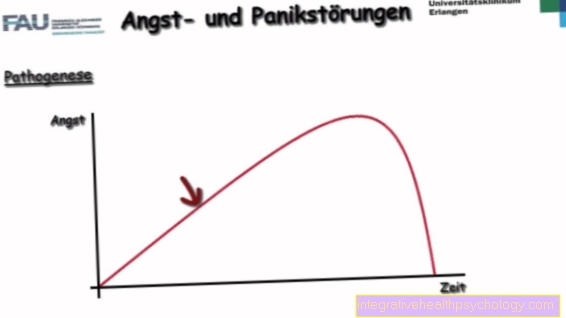Viral infection
introduction
A viral infection causes different diseases in the body, depending on which pathogen it is and how it enters the body. Viruses enter an organism, settle and multiply. The viruses enter the body in different ways. Cold and flu viruses are usually transmitted by droplet infection and settle on the mucous membrane of the nose or throat. Other viruses get into our bodies through injuries or even food.
You can also read about this: The build up of viruses

causes
The cause of the development of a viral infection is the successful penetration of the virus into an organism. Viruses can be infected in various ways. Many viruses are transmitted via droplet infection. They get into the air from already infected people when they talk, cough or sneeze. If these viruses reach the mucous membranes of other people's upper respiratory tract from there, they become infected. This is how the runny nose, measles, and chickenpox viruses are spread.
In the case of contact / smear infection, in contrast to droplet infection, the viruses are not transmitted via the air, but via the body excretions of infected people or animals. Contact infection is when the person concerned comes into direct contact with the infected person.
Viruses can also be transmitted indirectly, for example through contaminated objects or food. Examples of this are Ebola and polio.
Other viruses are transmitted via body fluids, i.e. through direct contact with the mucous membrane or blood. Such viruses are, for example, the HIV and hepatitis viruses B and C.
You might also be interested in this topic:
- Droplet infection
- Smear infection
How is a viral infection different from a bacterial infection?
There are differences between viral and bacterial infections. In the case of a viral infection, the temperature is often elevated (37-38 ° C), while fever is more likely to occur in bacterial infections (often over 38.5 ° C). In the case of an infection caused by bacteria, the symptoms hardly improve for days and pain usually only occurs in the affected part of the body (e.g. ear).
In contrast, the symptoms of a viral infection slowly improve day by day and the malaise is mostly spread throughout the body. Such a viral infection usually lasts for 3 to 10 days and leads to an improvement in the symptoms even without treatment. A bacterial infection can last from 5 days to 14 days and, if left untreated, often shows no improvement in symptoms. Only a doctor can clearly determine whether a viral or bacterial infection is actually present.
These symptoms indicate a viral infection
There are many different viral infections. Every viral infection triggers different symptoms and complaints.
Known virus infections are:
- chickenpox
- rubella
- measles
- poliomyelitis
- HIV infection
- hepatitis
- and TBE infection.
Chickenpox is a classic rash with small, sometimes unbearably itchy spots.
Rubella can cause a reddish rash and a slightly elevated temperature.
In measles, the precursor stage is similar to flu, later characteristic Koplik spots appear.
Polio often begins with unspecific symptoms such as nausea, diarrhea, fever, muscle pain and can cause flaccid paralysis.
An HIV infection runs in different stages of the disease and leads to different complaints and diseases. The last stage is called AIDS, and those affected suffer from various infections and even cancer.
With hepatitis general symptoms can occur (malaise, tiredness, fatigue, fever) and liver problems up to and including liver failure.
TBE viruses cause flu-like symptoms, fever and, in some people, a dangerous inflammation of the brain and meninges (meningoencephalitis).
Viruses also cause diseases such as diarrhea, respiratory infections, flu-like infections and conjunctivitis. A flu infection is a more harmless viral infection. Those affected often have a fever, chills and feel tired and underperforming. A flu-like infection can be accompanied by a sore throat, cough and hoarseness. Often, but not always, a viral infection is accompanied by an increased temperature and discomfort throughout the body (so-called body aches). With simple infections, symptoms improve day by day.
Read more on the topic: influenza virus
therapy
Virus infections are generally treated symptomatically. That means the doctor only relieves the symptoms. Those affected can do various things themselves to get better faster. It is important to allow the body enough rest and, above all, a lot of sleep. In the event of a virus infection, it is essential to drink enough fluids, especially water and tea.
A humidifier can be helpful if you have cold symptoms. If you have a sore throat, lozenges or gargling salt water can help. It also helps take in vitamin C and zinc.
Medicines that are used for viral infections include pain relievers, antipyretic drugs, and nasal sprays. For serious viral infections such as HIV, there are certain drugs that minimize the viral load in the blood. Such therapy lasts lifelong and must be checked by a doctor on a regular basis. Some viral infections can also be prevented by getting vaccinated. This applies to polio, measles, mumps, rubella, chickenpox and hepatitis B.
Find out about vaccinations against viral diseases: Vaccinate
Why don't antibiotics help against viral infections?
Taking antibiotics is pointless if you have a viral infection and can also have negative effects on your health. Antibiotics only work against bacteria. If you take antibiotics too often, the body becomes resistant to certain drugs. In order to prevent resistance, antibiotics should only be taken if there is a confirmed bacterial infection.
Because viruses live inside host cells, they are difficult to reach. They provide drugs with fewer points of attack, so it is best if the immune system itself fights virus-infected cells. Bacteria grow and feed differently. One can intervene in the metabolism of bacteria without destroying human body cells. Antibiotics therefore only work against bacteria. For example, they attack the cell wall (penicillin) or destroy other cell components of the intruders.
Duration
Mild virus infections last an average of 3 to 10 days. A flu-like infection can last differently from person to person. The duration also depends on comorbidities and the state of the immune system. A viral infection can be the starting point for an additional bacterial infection. Then doctors speak of a superinfection / secondary infection. In such a case, the common cold can lengthen significantly in duration and course.
A simple cold caused by viruses usually doesn't last more than a week. If there is a superinfection with bacteria, the duration of the disease can be prolonged and possibly last for a few weeks. The duration is also extended if you do not take enough care of yourself and start exercising too early.
Course of disease
A simple viral infection such as a flu-like infection lasts an average of one week in a healthy person. It takes about three days from infection to the onset of the disease (incubation period). The pathogens, often rhino or adenoviruses, initially cause mild discomfort such as a scratchy throat or a runny nose.
Symptoms increase within two days and are most pronounced on the second or third day. After that, the symptoms subside a little more every day. If it comes to a superinfection with bacteria, the simple cold can become more complicated. The tonsils, eyes, sinuses or lungs can become inflamed. A superinfection can last for several weeks and requires medical treatment. In infections with more complex viruses, the course can be different and have consequences.
You might be interested in this topic: Flu complications
How contagious is a viral infection?
Not all viruses are equally contagious. Some are only transmitted through intensive contact (blood, sexual intercourse), others are so highly contagious that staying in the same room is sufficient for infection. Other pathogens can be found through food or contaminated water. Viruses are basically contagious, but there are big differences among viruses.
Why is it not possible to vaccinate against all viral infections?
Vaccination is used to "train" / prepare the body against a specific virus so that it produces antibodies against the virus. There are strains of viruses that change frequently. Examples are flu viruses. Influenza vaccinations are offered, which are changed and adjusted every year and yet do not catch all virus strains. Another example is the HI virus, which is constantly changing its genome and therefore does not provide a point of attack.
You may also be interested in this topic: Vaccinations for adults
The most famous viral infections
flu
Influenza is a sudden feverish viral infection caused by various flu viruses (influenza viruses A, B, and C). The flu typically occurs more frequently in terms of time and space, and this is referred to as a flu wave. Sick people suddenly feel very sick.
The infection takes place via the droplet infection (sneezing, coughing, speaking), through direct contact with infected people (e.g. shaking hands) or via objects to which the influenza viruses adhere.
The first symptoms are:
- fever
- Sore throat
- cough and sneeze
Real influenza has a high fever of more than 39 ° C, which can last for days. More symptoms like
- Chills,
- Head, muscle, joint and back pain,
- Hoarseness,
- Nausea, A.
- Loss of appetite
- and exhaustion can occur
You can find detailed information at: Flu symptoms
HIV
HIV is the abbreviation for the HI virus, human immunodeficiency virus. HIV is not the same as AIDS. AIDS (Acquired Immuno Deficiency Syndrome) is a disease / immune deficiency that develops in the course of HIV infection.
HIV infection proceeds in stages. The acute HIV disease after infection corresponds to category A. This is followed by a symptom-free phase.
Category B includes the symptoms of chronic HIV infection and AIDS is used in category C.
The HIV virus is mainly transmitted through blood and semen, which is why people with unprotected sex or drug addicts who exchange syringes are particularly at risk. The viral infection cannot be cured, but the therapeutic options are getting better and better. A healthy lifestyle and appropriate medication aim to delay the transition to category C, the AIDS disease, as long as possible and to alleviate symptoms.
You can read everything about HIV at: The HI virus
hepatitis
Hepatitis is inflammation of the liver that can be caused by several things:
- Viruses,
- Poisons,
- Medication
- and autoimmune diseases
can be responsible for it.
In most cases, viral diseases are responsible. Viral hepatitis is caused by hepatitis viruses A, B, C, D, or E. Numerous people around the world are infected with hepatitis B and C. The hepatitis types A and E are transmitted through contaminated water or food, while the remaining hepatitis viruses are spread through contact with the blood and mucous membranes. The symptoms can vary. In some people, the infection is symptom-free until the inflammation of the liver is revealed by increased liver values in the blood.
Other sufferers are sent away incorrectly diagnosed with a flu-like infection due to their unspecific symptoms (fever, nausea, vomiting, loss of appetite, joint and muscle pain). Others have jaundice. As a rule, acute hepatitis occurs first, which then becomes chronic. Depending on the hepatitis pathogen, there are different therapy options to slow down the progression of the liver inflammation as much as possible.
You can find everything about hepatitis at:
- hepatitis
- Hepatitis A
- Hepatitis B.
- Hepatitis C.
- Hepatitis D
- Hepatitis E.
Cytomegaly
Cytomegaly (CMV infection) is an infectious disease caused by the cytomegalovirus (CMV). The viruses are often transmitted from mother to child during pregnancy. The CMV is particularly dangerous for the immunocompromised.
Cytomegaly can affect all organs and flare up again and again throughout life.Transmission to newborns can cause severe symptoms such as water head (hydrocephalus) or coagulation disorders in the child and lead to premature birth. CMV infection can occur without symptoms in healthy children and adults. Therefore, screening for CMV in pregnant women is important.
You can find more about this in our topic: Cytomegalovirus
How long is the incubation period?
The incubation time ((period between infection and the exhaustion of the disease) is highly dependent on the different viruses in the case of a virus infection. Influenza viruses, for example, have a relatively short incubation time of a few hours to three days.
The flu is contagious during the incubation period. Other viruses can have significantly longer incubation times. Once infected, the HI virus has an incubation period of one to three weeks. The disease can take months or years to make itself felt. If the TBE virus is transmitted by a tick bite, the virus has a variable incubation time between 2 and 30 days.
Why do viral infections cause joint pain and muscle pain?
In the context of a viral infection, defense reactions arise from our immune system. These arise not only locally, but throughout the body. There are more immune cells everywhere and so-called pyrogens are released. These are messenger substances that increase body temperature. The hormone mediators prostaglandins are released with the pyrogens. The prostaglandins also promote a rise in temperature, but also cause increased pain perception. Prostaglandins are messenger substances that occur naturally in healthy people. If the amount of prostaglandins rises sharply in the event of a viral infection, pain in the joints and muscles is more pronounced. This means that viral infections cause joint and muscle pain through an increased release of hormone-like active substances, the prostaglandins.
Do you suffer from body aches? Read more about this under: Pain in the limbs





























